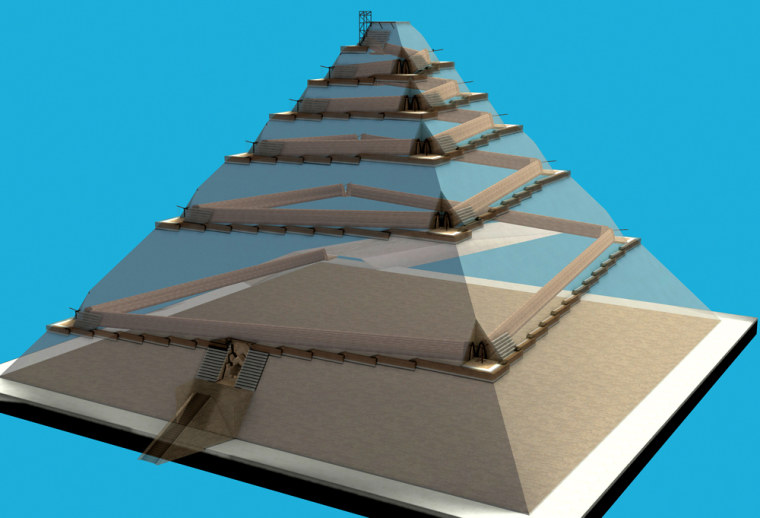A French architect says he has cracked a 4,500-year-old mystery surrounding Egypt’s Great Pyramid, claiming that it was built from the inside out.
Scientists have long wondered how the Egyptians placed the Great Pyramid's 3 million stone blocks, which each weigh about 2.5 tons. Previous theories have suggested that the tomb of Pharaoh Cheops (Khufu), the last surviving example of the seven great wonders of antiquity, was built using either a vast frontal ramp or a ramp in a corkscrew shape around the exterior to haul up the stonework.
But flouting previous wisdom, Jean-Pierre Houdin said advanced 3-D technology has shown that the main ramp used to haul the massive stones to the apex was contained 30 to 50 feet (10 to 15 meters) beneath the outer skin, tracing a pyramid within a pyramid.
According to his theory — shown in a computer model available on the Internet — the builders put up an outer ramp for the first 140 feet (40 meters), then constructed an inner ramp in a corkscrew shape to complete the 450-foot-high (137-meter-high) structure.
“This is better than the other theories, because it is the only theory that works,” Houdin said Friday after unveiling his hypothesis in a lavish ceremony using 3-D computer simulation.
To prove his case, Houdin teamed up with a French company that builds 3-D models for auto and airplane design, Dassault Systemes, which put 14 engineers on the project for two years. Now an international team is being assembled to probe the pyramid using radars and heat-detecting cameras supplied by a French defense firm, assuming that Egyptian authorities will agree.

“This goes against both main existing theories. I’ve been teaching them myself for 20 years, but deep down I know they’re wrong,” Egyptologist Bob Brier told Reuters at the unveiling.
“Houdin’s vision is credible, but right now this is just a theory. Everybody thinks it has got to be taken seriously,” said Brier, a senior research fellow at Long Island University.
Egypt’s Supreme Council of Antiquities was not immediately available for comment. Dassault said Brier and other Egyptologists attending the ceremony were supporters of Houdin’s theory but had no financial links to him or the firm.
Flash of intuition
Houdin began working full-time on the riddle eight years ago after a flash of intuition passed to him by his engineer father, and five years before actually visiting the site.
He found that a frontal, mile-long ramp would have used up as much stone as the pyramid, while being too steep near the top. He believes an external ramp was used only to supply the base.
An external corkscrew ramp would have blocked the sight lines needed to build an accurate pyramid and would been difficult to fix to the surface, while leaving little room to work.
“What characterized the Egyptians was their sense of perfection and economy. We talk of durable development now, but it was the Egyptians who invented it. They didn’t waste a single stone. They relied purely on intelligence,” Houdin said.
Yet another enigma
Houdin also claimed to have shed light on a second enigma surrounding the purpose of a Grand Gallery inside the pyramid.

The Frenchman believes its tall, narrow shape suggests it accommodated a giant counter-weight to help haul five 60-ton granite beams to their position above the King’s Chamber.
He thinks that no more than 4,000 people could have built the pyramid using these techniques, rather than the 100,000 or so assigned by past historians to the task of burying the pharaoh.
Houdin, 56, brushed aside concerns about the popular curse that is supposed to punish those who penetrate the secrets of the pyramids, dating back to the opening of Tutankhamun's tomb.
“Why should I be worried? I’m just explaining that the people of the time were architects of genius and that Khufu was a genius to order the pyramid’s construction. What could happen to me, except that Khufu would thank me?” he told Reuters.
This report includes information from Reuters and The Associated Press.
